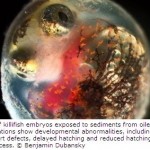Despite sharp increases in carbon dioxide emissions by humans in recent decades that are warming the planet, Earth’s vegetation and oceans continue to soak up about half of them, according to a surprising new study led by the University of Colorado Boulder.
The study, led by CU-Boulder postdoctoral researcher Ashley Ballantyne, looked at global CO2 emissions reports from the past 50 years and compared them with rising levels of CO2 in Earth’s atmosphere during that time, primarily because of fossil fuel burning. The results showed that while CO2 emissions had quadrupled, natural carbon “sinks” that sequester the greenhouse gas doubled their uptake in the past 50 years, lessening the warming impacts on Earth’s climate.
“What we are seeing is that the Earth continues to do the heavy lifting by taking up huge amounts of carbon dioxide, even while humans have done very little to reduce carbon emissions,” said Ballantyne. “How long this will continue, we don’t know.”
A paper on the subject has been published in the August 2 issue of Nature. Co-authors on the study include CU-Boulder Professor Jim White, CU-Boulder doctoral student Caroline Alden and National Oceanic and Atmospheric Administration (NOAA) scientists John Miller and Pieter Tans. Miller also is a research associate at the CU-headquartered Cooperative Institute for Research in Environmental Sciences.
According to Alden, the trend of sinks gulping atmospheric carbon cannot continue indefinitely. “It’s not a question of whether or not natural sinks will slow their uptake of carbon, but when,” she said.
“We’re already seeing climate change happen despite the fact that only half of fossil fuel emissions stay in the atmosphere while the other half is drawn down by the land biosphere and oceans,” Alden said. “If natural sinks saturate as models predict, the impact of human emissions on atmospheric CO2 will double.”
Ballantyne said recent studies by others have suggested carbon sinks were declining in some areas of the globe, including parts of the Southern Hemisphere and portions of the world’s oceans. But the new Nature study showed global CO2 uptake by Earth’s sinks essentially doubled from 1960 to 2010, although increased variations from year-to-year and decade-to-decade suggests some instability in the global carbon cycle, he said.
White, who directs CU-Boulder’s Institute of Arctic and Alpine Research, likened the increased pumping of CO2 into the atmosphere to a car going full throttle. “The faster we go, the more our car starts to shake and rattle,” he said. “If we drive 100 miles per hour, it is going to shake and rattle a lot more because there is a lot more instability, so it’s probably time to back off the accelerator,” he said. “The same is true with CO2 emissions.”
The atmospheric CO2 levels were measured at 40 remote sites around the world by researchers from NOAA and the Scripps Institution of Oceanography in La Jolla, California, including stations at the South Pole and on the Mauna Loa Volcano in Hawaii.
Carbon dioxide is emitted into the atmosphere primarily by fossil fuel combustion and by forest fires and some natural processes, said Ballantyne. “When carbon sinks become carbon sources, it will be a very critical time for Earth,” said Ballantyne. “We don’t see any evidence of that yet, but it’s certainly something we should be looking for.”
“It is important to understand that CO2 sinks are not really sinks in the sense that the extra carbon is still present in Earth’s vegetation, soils and the ocean,” said NOAA’s Tans. “It hasn’t disappeared. What we really are seeing is a global carbon system that has been pushed out of equilibrium by the human burning of fossil fuels.”
Despite the enormous uptake of carbon by the planet, CO2 in the atmosphere has climbed from about 280 parts per million just prior to the Industrial Revolution to about 394 parts per million today, and the rate of increase is speeding up. The global average of atmospheric CO2 is expected to reach 400 ppm by 2016, according to scientists.
The team used several global CO2 emissions reports for the Nature study, including one by the U.S. Department of Energy’s Carbon Dioxide Information Analysis Center. They concluded that about 350 billion tons of carbon – the equivalent of roughly 1 trillion tons of CO2 – had been emitted as a result of fossil fuel burning and land use changes from 1959 to 2010, with just over half moving into sinks on land or in the oceans.














